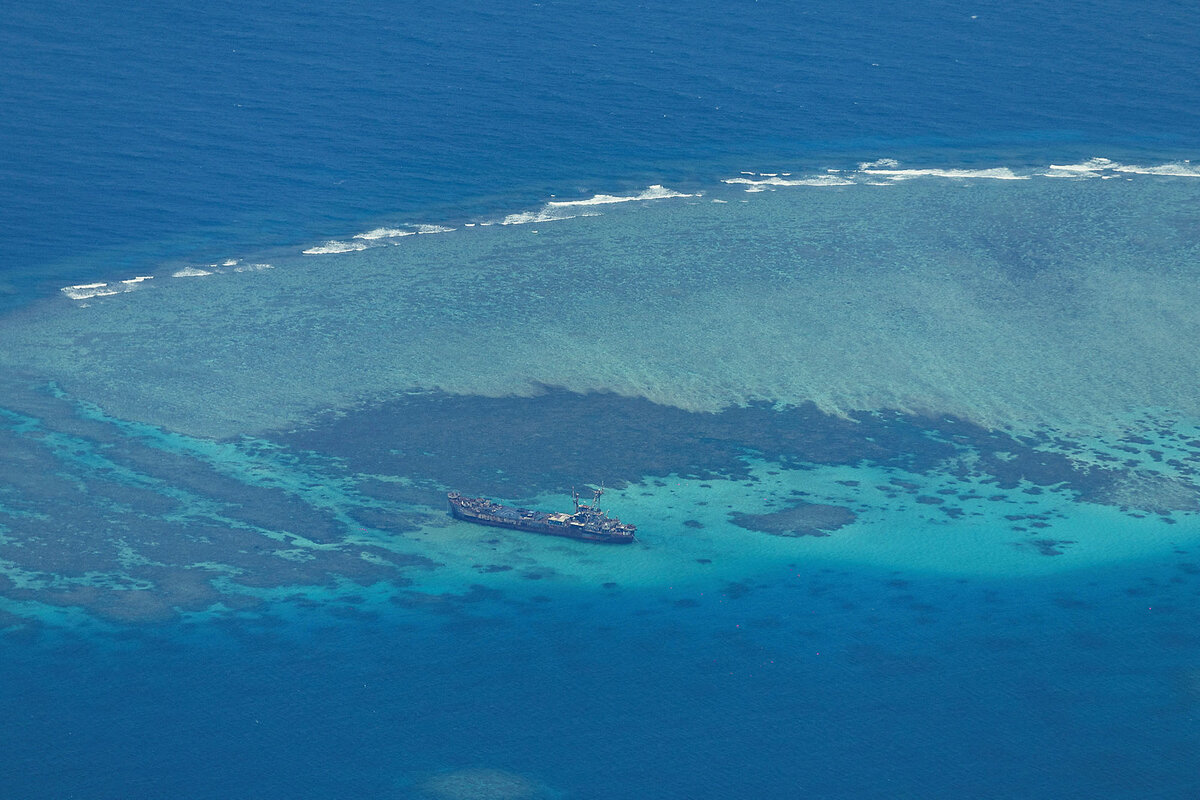How China-Philippines tensions are bringing South China Sea conflict to new brink
Loading...
Chinese and Philippine coast guard ships collided this week in a fresh clash between the Asian superpower and its neighbor in the South China Sea. The escalation of the territorial dispute in the strategic waterway has brought China and the Philippines – a U.S. treaty ally – to a new and dangerous brink, despite recent efforts by both sides to cool tensions.
Reportedly the first direct skirmish between the two sides at Sabina Shoal in the sea’s Spratly Islands archipelago, the incident marks an expansion of a long-simmering conflict that has worsened over the past year, due largely to China asserting its expansive claims over the South China Sea.
“China really sets the tone,” says Ian Storey, senior fellow at the ISEAS-Yusof Ishak Institute in Singapore and an expert in Asian security. “When China is more assertive, tensions go up.”
Why We Wrote This
A story focused onChina’s expansions in the South China Sea are shifting power dynamics in the valuable, disputed waterways, complicating efforts to maintain peace.
What happened in the latest clash, and what is at stake?
On Monday, coast guard vessels of China and the Philippines crashed into one another near Sabina Shoal, causing damage to at least two of the ships, according to statements from each government. Beijing and Manila blamed each other for the collision, and reported no injuries to crew members.
It’s a new flashpoint in the conflict over a vast, 1.4 million-square-mile waterway stretching from southern China and Taiwan to the Philippines, mainland Southeast Asia, and Indonesia. The South China Sea is valued for its vital shipping lanes, rich fish stocks, and coral, as well as oil and gas resources; the area contains an estimated 11 billion barrels of oil reserves, and 190 trillion cubic feet of natural gas.
China and the Philippines have overlapping claims in the South China Sea, including over the Sabina Shoal. The disputed atoll lies inside the Philippines’ 200-nautical-mile-wide exclusive economic zone as defined by the 1982 United Nations Convention of the Law of the Sea. A 2016 arbitration ruling by an UNCLOS tribunal found that China’s claims, land reclamation, and other activities in Philippine waters were unlawful. But China has refused to abide by the ruling, rejecting it as “null and void.”
Monday’s collision follows a violent skirmish in June that injured a Filipino sailor near another feature of the Spratly Islands archipelago, Second Thomas Shoal. Manila has an outpost there on a beached Philippine warship. After that incident, Beijing and Manila held talks and came to an unpublicized agreement over the Philippines’ resupply missions.
“They ... pulled back,” says Dr. Storey. “Both sides realize that if they continued ... it would have raised the risk of a clash, possibly leading to fatalities.”
Manila this week reiterated that it prefers diplomacy to address the ship collisions. Still, he adds, “It’s unclear how long that agreement will remain in place.”
How has China “set the tone” in the South China Sea?
Over the past decade, China has accelerated its efforts to enforce its expansive territorial and jurisdictional claims to most of the South China Sea.
China claims a majority of the strategic waterway using a vaguely defined “nine-dash line” that extends deep into the exclusive economic zones of other claimants including the Philippines, Vietnam, Malaysia, Brunei, and Indonesia. It has beefed up this effort despite the 2016 UNCLOS ruling that held its “nine-dash line” had “no legal basis.”
China has built artificial islands in the Spratly chain and militarized them, building runways and deploying advanced anti-ship and antiaircraft missile systems. These outposts have allowed China to bolster its military and paramilitary presence in the South China Sea, using its rapidly expanding coast guard fleets to gain de facto control.
How have smaller claimant nations responded?
Unlike in past decades, China today is able to maintain a continual military proximity to disputed areas of the South China Sea that dwarfs that of other claimants. “There is a huge asymmetry of power,” says Dr. Storey. “The Southeast Asian claimants can’t really stand up to China in any military way, so they ... continue to protest China’s activities, [and] to monitor.”
Vietnam, for example, was able to occupy several land features in the Spratly Islands chain in the 1980s before China’s rise, allowing it to maintain a small but effective force in the area, experts say.
In recent years, the Philippines has gained stronger intelligence capabilities for monitoring the Chinese coast guard, and it’s also establishing a foothold on some islands from which it can mount more rapid, shorter-distance patrols.
Smaller claimants also engage in consultations with China to ease tensions – as the Philippines has done recently. Yet while such talks can help reduce the possibility of violent conflict, they are unlikely to achieve a fundamental resolution of the territorial disputes, experts say.
What can the United States do to support allies and counter China’s aggression?
The U.S. State Department on Monday condemned “dangerous and escalatory” actions by China against “lawful Philippine maritime operations” and said it stands with its ally the Philippines. It reaffirmed Article IV of the 1951 U.S.-Philippines Mutual Defense Treaty, noting that it includes attacks on the Philippine coast guard anywhere in the South China Sea.
The United States makes no territorial claim in the South China Sea, and advocates for the peaceful resolution of disputes on the basis of international law. It does have vital interests in keeping the sea lanes open, and the U.S. military conducts regular “freedom of navigation” patrols in the South China Sea to challenge what Washington considers excessive maritime claims.
Still, some experts say the U.S. could do more to push back on China’s growing assertiveness in the South China Sea, without being provocative.
Diplomatically, the U.S. could organize talks among Southeast Asian states to promote agreement over the rights granted by controlling land features, says Oriana Skylar Mastro, a Center Fellow at the Freeman Spogli Institute for International Studies at Stanford University.
Militarily, the U.S. could expand its treaty commitments to cover support for operations within the exclusive economic zones of treaty allies. It could also mount selective, occasional military escort missions together with allies such as the Philippines in the South China Sea. “The United States doesn’t have to escort every single ship,” says Dr. Mastro, author of “Upstart: How China Became a Great Power.” “We can reserve the right to do it, and do it periodically, especially when things are under fire.”








